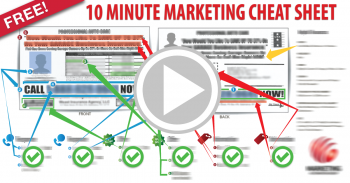Category Archives for Business
Looking for Profit in all the Wrong Places
 Take Charge of the Numbers to Take Charge of Your Business
Take Charge of the Numbers to Take Charge of Your Business
I talked recently about numbers that tell us something about the current business climate. Now let’s talk about the numbers that make, or break, your business.
Dawn Fotopulos is the HiddenProfitProphet. I had a chance to sit down recently with this award-winning author, educator, and entrepreneur to talk about how small business owners can get a handle on their financial details, do better business—and make more profit. I got to know Dawn when she joined my MAG Elite Mastermind Group.
Dawn helps small business owners find profit where they least expect it—in their balance sheets. She wrote the best-selling book, Accounting for the Numberphobic: A Survival Guide for Small Business Owners, and offers great tips and advice on her website.
Smart financial moves—get the inside scoop from an expert
Talk to a mentor, advisor, or top talent in your field when you or your business drift. The later you look for help, the harder it is going to be on your business—and your profit. I work with professionals like Dawn to fine tune business plans and establish marketing strategies to crush their competition.
I talked to Dawn to get her take on financial questions common to all small business owners. Here are some of her responses to my questions. To learn more about Dawn’s great ideas—read her excellent book.
Q. At some point or other, entrepreneurs hit a wall. When struggling with their bottom line, what is the biggest mistake small business owners make?
A. Every business owner thinks if they’re having trouble paying the bills, they need more customers. They might very well be scaling an unprofitable business! In fact, that’s what many used car dealers are doing. They think if they sell more cars, they’ll make more money. It’s exactly the opposite. If you’re losing money on every deal, you really can’t make it up in volume.
Q. Do you find entrepreneurs are good with ideas, but challenged by their financial statements? If so, how are they challenged?
A. I took a poll at The New York Times Small Business Summit Conference over a five-year period. During that time, I asked 5,000 small business owners one simple question—“True or false, a Net Income Statement and a Profit and Loss Statement are the same thing.” Only one out of one hundred business owners knew that was true. That’s not a problem—it is an epidemic. Would you ever drive your car with your eyes closed? No. Then learn how to read your financial dashboard. By financial dashboard, I mean your Income Statement, Cash Flow Statement and Balance Sheet. These documents are key to running your business and making good decisions. No matter what business you’re in, you must be able to answer three questions:
– Are you making money?
– Do you have enough cash to pay the bills?
– Are you building wealth or destroying it?
Your financial dashboard will answer each of these questions.
Q. Do you encounter small business owners who are afraid of the financial work in front of them? Why do you think that is? What are they most afraid of?
A. They’re not afraid; they’re terrified.
It’s too intimidating. They feel like they have to become an accountant. If they’ve taken accounting courses, they never understood debits, credits and reconciliation. What if a business doesn’t need to learn how to keep the books—but just learn how to read their financial dashboard?
Many think their accountant’s job is to read their financial dashboard. Your accountant will not run your business any more than your mechanic will drive your car. It’s your job to navigate.
Your financial dashboard shows you how. Most people are intimidated because the topic is complex and often taught by very knowledgeable but really boring people. That’s why I wrote the book and had it illustrated by a Disney artist. It was time to make running a business fun, exciting and interesting again. If you look at the comments on Amazon, you’ll see many people who were once intimidated are now finally gaining the confidence they need to run profitable, cash-rich companies.
Q. You have written a well-received book about diving into financial details. Can you explain a couple of concepts from the book, such as what are the most important financial documents and how can these documents help a small business owner?
A. The Net Income Statement is like the speedometer in your car. How fast is your business producing profits? Is your business beyond the breakeven point (is it self-sustaining)?The Cash Flow Statement is like your gas gauge. It will show you how much cash is available to run the company and for how long. Your Balance Sheet is like an oil pressure gauge. Too little pressure (debt), and you don’t have ignition. Too much debt, and you’ll go bankrupt. The Balance Sheet is also the Net Worth Statement of the business. Every banker and investor scrutinizes this statement. Make sure you know how to read it, and improve on it from operations. These statements are your GPS for running your business. Think about it, if you want to get to your destination, wouldn’t it be helpful to have a path to get there? I can get to Ogden, Utah, by trial and error but it will take my lifetime that way. These financial statements, like a GPS, get to you the promised land of living off your own cash flow a lot faster.
Q. What are the basic steps an entrepreneur can take to manage these important details and create profit?
A. Gross margin. Gross margin. Gross margin. Ever watch Shark Tank? Like the sun rising in the east, every business owner is asked, “what are your margins” on their products. Why? Because margins drive profitability. There’s a lot more I can say to your question. The best thing to do is read my award-winning book, “Accounting for the Numberphobic; A Survival Guide for Small Business Owners.” It won “Best Business Book of 2015 in Economics” from Small Business Trends. The book takes you by the hand and explains, line by line, what’s happening in your business and provides you simple, no-cost strategies to fix the broken things. It should be mandatory reading for anyone going into business.
Q. Are there accounting and profit choices you would make differently for a products-based versus a service-based business?
A. Valuing time is perhaps the biggest challenge for service providers. Also, managing invoicing and billing becomes more complicated, especially for service providers who work on multi-phase projects. Time is your only recoverable asset so keeping track of that, especially as it relates to direct labor costs, is crucial.
I’ve seen many service providers who are so busy giving great service to their clients, they don’t track how much time that’s actually costing them. A large client could in fact be their least profitable client.
In either product or service businesses, the owners need to look at their gross margin two ways—by product or service and by client. For the business owners who have purchased my Hidden Profit Academy courses, they get this. That gives them visibility to really know what products or services are working hard for them and which ones to change or eliminate.
Q. In a downturn or even when the invoices have not yet been paid, how can small business owners maintain their cash flow?
A. First, you have to diversify your client base. If you only have one or two big clients, you’re at risk if either of them leaves or falls on hard times.
Second, you have to have two ways out of the room. Always apply for a credit line when you don’t need it, then you have it if cash gets tight.
Stay on top of your accounts receivables aging report like a hawk. Know exactly who owes you money, how much, and for how long. If any receivable ages beyond 30 days, the likelihood you’ll ever get paid goes down dramatically.
Learn how to collect outstanding debts from clients. This is a more important skill than learning how to sell. Business owner need to learn this early on. My book provides sample openings and dialogues to do this painlessly. Chapters 5 and 6 are worth the entire ten chapter book.
Q. You have talked about simple steps, “One Thing,” to add cash to your business account right away. Can you give us one or two tips?
A. Make sure your invoice includes not just the date of delivery, but what you delivered to your client. Remind them of what a great decision they made to hire you. You didn’t just build a website, you improved the customer experience and thus the client gained increased traffic and engagement. Once they read this, they can’t wait to pay the bill. Stop waiting too long to send the client an invoice. Invoice them weekly or bi-weekly. You’ll get paid faster and the client won’t be overwhelmed.
Q. What financial trends do you see with small businesses, the recovering economy, and a faster paced, more volatile market for goods and services?
A. Nimbleness is key. Don’t make or accept long-term commitments. Be on top of technology. Everything you can do to save time, decrease error rates, and to streamline daily processes is worth your investment. In terms of macro trends, I’m most concerned about central bank policy. No society in the history of man has survived currency debasement over the long haul. Just ask the Romans.
Take control of your business by understanding your real financial situation. Get good counsel about your financial dashboard—and your business or marketing plan—to make more money doing what you love. When you are ready to ramp up your income—call me at 585-633-7563.
Yours in profit,
Bob Britton
Signal or Noise? How Do Your Help Your Customers Choose You?
 You have a terrific product or service—and a lot of competition for the business. How do you help your target customer choose you?
You have a terrific product or service—and a lot of competition for the business. How do you help your target customer choose you?
My business is helping you identify, attract, and land the customers you want, to make the profit you need. As a small business owner, I know what works, and how to use marketing technology to steer business your direction, and keep it coming.
But when it gets down to it, how do you help your client hear your message, and understand your brand, through all the noise? It is not as hard as you think.
The dynamics of choice and marketing
A lot is written about the psychology of choice. Drill into the topic and you’ll find research looking at why people make the choices they do.
Understanding why people make choices is important. As small business owners, we want to know how to influence choice to get more business. Poor marketing and product lines mean your premium clients go elsewhere.
As a consumer, you know what it takes to convince you to buy. Taking that perspective is important when thinking about how to sell to your client base. Consider these points about the experience of choice:
- Choice: It is important to do what you do best. If you sell one product, or one type of service, you need to be the absolute best and understand that you are working in a niche market. In a TED talk, author Malcolm Gladwell talks about choice—and spaghetti sauce. The take-home point is that there is no one kind of human, so offering few products, or services, could be a limiting factor to your business.
- Too much choice: Plentiful research bolsters the belief that too much choice is not a good thing. Offering a dizzying array of information, products, or services is just that—dizzying. Chances are good you will land a customer if you have a lot of choice—just make sure the choice is presented in a way it can be consumed. Design your website with filters, make auto-suggestions, enable reviews, and offer pages with a limited number of products, to create a pathway to purchase in digestible bits.
- Bias and other fine qualities: Your client approaches your business with pre-conceived ideas. How you present yourself, or your product, plays to their needs, fear, and identity. Humans place inordinate weight on the first information they receive about a person, place, or thing. If a good friend liked your restaurant, your new customer is predisposed to like it, too. If a client reads a negative review of the service you sell—you need to work harder to overcome that bias. If a customer is in need of basic information, your knowledge of your product—without an initial sales attempt—gives you a chance to create the image of a knowledgeable, trusted ally instead of a pushy salesperson.
Sales work is mostly psychology, with products mixed in. Know your customer, and know what you are really trying to sell.
To get to the sell, start at the beginning
Most people can sell something once. To profit and grow your business, you have to meet the needs of your customer repeatedly. Marketing hype has its place, but the bottom line is that you have to understand your business from the viewpoint of your customer.
There is a well-known story about the angel investor who kick-started Apple. Everyone starts somewhere and Apple founders, Steve Wozniak and Steve Jobs, originally worked out of a garage. Their first investor was Mike Markkula. As the story goes, Mr. Markkula also wrote a three-part marketing platform that continues to serve this very successful company.
The three mandates written by Mr. Markkula in 1977 remain effective and include:
- The quality of empathy: “We will truly understand their needs better than any other company.”
- The ability to focus: “In order to do a good job of those things that we decide to do, we must eliminate all of the unimportant opportunities.”
- Recognition of people to impute: “People DO judge a book by its cover. We may have the best product, the highest quality, the most useful software etc.; if we present them in a slipshod manner, they will be perceived as slipshod; if we present them in a creative, professional manner, we will impute the desired qualities.”
Take what we know about the science of choice, combine it with rock-solid marketing philosophy, and a great product, and you are on your way to small business success.
By understanding your own business, you can help your customer make a choice that benefits both of you. When you need help understanding the bottom-line of your business, call me at 585-633-7563, I can help.
Yours in profit,
Bob Britton
Business: Going Up! Going Down! What’s Behind the Numbers?
 One report says business start-ups have never looked better. Another survey talks about persistent decline. With the business outlook in churn, what do the numbers mean to you?
One report says business start-ups have never looked better. Another survey talks about persistent decline. With the business outlook in churn, what do the numbers mean to you?
While you focus on landing that client, or pivoting your marketing message, the economy is moving fast. Getting to market with a good plan, new ideas, and great products makes for a winner, but it is also important to understand your business ecosystem—is it healthy?
New reports: Do statistics lie?
Numbers are important to any business owner. Your bottom line, your profit margin, your price point—every number carries weight. In terms of business climate, let’s take a look at some overall reports:
The Brookings Institution: This organization recently released a study on business dynamism, the churn that occurs when companies start-up, succeed, grow, or fail. Its findings include:
- Statistically, a new business starts each minute, while another fails every 80 seconds.
- Business dynamism, the growth and decline of companies in the private sector, has fallen for years.
- Reduced dynamism results in slower economic growth.
- New regional and national measures are needed to fuel small business growth.
Kauffman Index: According to a study from the Kauffman Foundation, 2014 saw the strongest entrepreneurial growth since 2010. Some interesting entrepreneurial points include:
- Most new small business owners are men, at approximately 63 percent. According to the report, the rate of new female entrepreneurs is near a two-decade low.
- Called opportunity entrepreneurs, owners who are not unemployed—and starting a business by choice—represent the largest number of new small business owners, at more than 79 percent.
- Up from just over 13 percent in 1997, immigrant entrepreneurs now account for more than 28 percent of new small business owners.
Notes Kauffman study author Arnobio Morelix, “When broad-based entrepreneurial opportunity improves at this pace, it’s an indication that the labor market is slowly recovering.”
Global Entrepreneurship Monitor (GEM): GEM is a joint collaboration involving more than 69 countries and conducts research on entrepreneurship around the world. Some GEM data on American entrepreneurs includes:
- In the United States, there are approximately 24 million entrepreneurs, representing about 14 percent of the population. This represents a high-water mark for the 16-year GEM study.
- More than six percent of start-ups currently occur within organizations—meaning entrepreneurial efforts are being supported through, and by, larger corporate environments.
- Of the surveyed countries, the United States reports the highest number of entrepreneurs between ages 55 and 64 years of age.
- Twenty-one percent of entrepreneurs expect to create 20, or more, job positions in the next five years.
Why do numbers matter?
With absolute certainty, I can say these reports agree on one point—it remains an unsteady business environment. The confluence of economic indicators, new jobs, oil prices, and global politics play an important role in the local business environment where you operate your company.
I work with entrepreneurs to maximize the profit they earn—or will earn when starting up a new business. In the initial one to three years of your business lifecycle, the seeds of success and failure are sown. When I work with business owners, we look at expansion—or contraction—when needed, or replacement of outmoded operations with lower cost marketing automation to reduce labor and time expenses.
To gauge risk and support growth, it is important to keep an eye on the economic climate for a couple of reasons:
- Knowing the cost of goods is important. The Producer Price Index (PPI) looks at the cost of goods and materials for manufacturers and producers. When the cost of materials goes up—you need some savvy to understand whether you should raise your prices, or hold on. Keeping an eye on the overall cost of materials helps you plan and price.
- In August, the overall employment picture did not change much, with some states reporting job loss—others reporting job gain. Regional and national unemployment trends are important to entrepreneurs. National rates give you a birds’ eye view of a larger cycle. Regional rates give raw information to plan for temporary downturn, or uptick in customer spending.
- In any particular season, it is good to know about consumer confidence. By some measures, 45 percent of reporting households noted a better financial picture in August of this year. When consumer confidence is up, your clients and customers may spend more. At present, recovery from the Great Recession continues, with bumps from volatility in the stock market, and oil prices.
What’s in a number? Plenty. When you want to understand your bottom line—and boost your income—call me at 585-633-7563.
Yours in profit,
Bob Britton
Rethinking the Unthinkable: Should You Fire a Client?
Marketing is all about generating solid client leads and conversions. We’re in this to build business, right? Sometimes marketing is also about knowing when to let a client go.
If you are a small business owner, you probably have—or have had—clients that just did not work out. For their reason, or yours, it was not a good relationship. My business is helping entrepreneurs craft a business that makes them real money.
Good reasons to let a client go
Client issues are different depending on your position in the business lifecycle. If you are a start-up, stretching services, straining your finances, and delivering the impossible may be your idea of landing a client. Established entrepreneurs may have clients on board that are not returning profit, compared to time needed to maintain their account. How do you know when to cut a client loose?
I have been where you are. Struggling with several businesses, it took me a lot of effort until I hit on a business strategy that worked—no matter what business I took on.
Today, I help clients with strategies for value, pricing, marketing, and production to create strong—profit-producing—small business enterprises. An important part of running your business is learning to recognize the clients that support your bottom-line. Consider these tips for identifying problem issues with clients—or potential clients:
- Not your expertise: Tempting though it is, avoid taking on clients who are asking for services outside your defined area of experience. If it is a field you are working into, or have an interest in exploring, by all means, take the challenge. But—small business owners anxious to succeed may take on projects or requests they are not set up to address, and end up at a financial loss for the time spent. When a client wants a product or service you do not provide, offer a referral or consider partner relationships with other small business owners who provide what your client needs.
- The money is not there: I have said this before—do not get into pricing wars with other business owners. You cannot win if the game is to undercut the competition. Unless you have the edge on a high volume business, the best position for an entrepreneur is as a premium player. Clients who haggle over every bill, are late paying, or always looking for a deal, are not the kind of clients who support your long-term growth and financial success. If you are an established business owner reconsidering your price point, take the time to speak with legacy clients. Let them know you are repositioning your services and offering a greater value proposition. Show them how they will get better—and more—service, even as they pay a higher price. If established clients are unhappy, let them make the choice to move on, but do not make special pricing deals to maintain unprofitable accounts.
- Bad business: Do your business on the sunny side of the street. Shady clients looking to make you a deal, or asking you to skirt a regulatory situation, are nothing but trouble. Turning down a sizeable account or a big payout may be tough—but it is worth it. In a wired world, reputation management is essential to your brand. Make sure you know what is being said about you—or about others you might be considering for a business relationship.
- Just not worth the trouble: We all have them—clients who pay on time, but cause you to involuntarily flinch when you hear their name. They may be argumentative, take a lot of time, always ask for a special deal—just something that makes doing business with them difficult. If it is your bread and butter client—you are stuck for the time being. When that is the case, it is time to hit your marketing strategy hard, and start looking for clients that offer a better reciprocal relationship.
- Is this you? A start-up business owner may ask you to take lower fees in exchange for stock options. Unless it was Google or Facebook—most times, these arrangements do not pan out. Or, you offer services involving consulting and guidance that your client never takes—often to their detriment. These examples point to a client that is just not a good fit.
Many small business owners recognize these clients, but fear turning them away, or letting them go, for financial reasons. Give yourself permission to choose the clients who really need your services, and who support your steady success—like you support theirs.
When you need to develop clients who appreciate what you have to offer—you need a marketing plan that delivers. Call me at 585-633-7563 to kick-start the right kind of client development for your company.
Yours in profit,
Bob Britton
Starting Up or Starting Over—A Few Things to Think About
Thinking about starting or relaunching your business? Both require serious consideration and a long-term plan.
Every year small business owners start, relaunch, and sell businesses. There are a million reasons why. I work with entrepreneurs to start and grow their businesses with the aim of turning a profit. A big profit. When you make more money, you can offer the service you want—at the price that sustains your lifestyle choices and family.
Starting up—five things to know
When considering starting your own business, there is a lot of work to be done. There are resources that can help you with the basics, and you need to give careful thought to questions like:
- Why do you want to start this business? Is it a mid-life moment, job—or even relationship—frustration, or is the time right for you to grab that idea and put your shingle out there?
- What is your value proposition? Go no further. I work every day with clients who have been in business for years, treading water without a lot of profit, who have no value proposition. What is a value proposition? It is how you intend to stand out from the crowd—what makes you so different that clients and businesses want to work with you. Types of value propositions include:
- Quality: You offer a product or service so much better that your business is the obvious choice
- Custom: Your services or product are special, or one-of-a-kind that cannot be obtained anywhere else
- Convenience and service: You make it so easy for people to get what they want that they have no reason to go elsewhere?
- You are us: You market your product or service so well, that your clients feel you know them, and that you would move mountains to make sure they are served
These are just a few types of value that make you different from the also-rans. Your value proposition can make or break your business—make sure you know the reason people would want to spend their money on what you have to offer.
- Who are your customers? Are you selling to a small, rarified niche of clients, or are you aiming for mass market? What are the benefits and downsides of both? What research have you done to prove you have a marketable product or service?
- Who—and where—is my competition? Are you in this alone? Do you have a stand-out product no one knows about yet? Getting to market fast is important. Are there lots of others at your price point selling the same thing? How are you going to compete? Are you a storefront, Web, or both? What is your marketing plan for each or other channels?
- Pricing: Along with marketing, competition, and value proposition—the price of your product is integral to your operation. Your pricing is affected by questions you might not know how to answer right now—how do you want to live, what kind of profit can you really make? What are the production, operation, marketing, and tax implications?
These are the types of questions I work over with entrepreneurs. Make sure you know these metrics inside and out before you invest your money, time, and a good chunk of your life in a new business.
Do you need to reboot?
Relaunch, pivot, and rebrand are all words used to discuss actions needed when you hit a wall—or a profit plateau—with your business.
Let’s say you have a moderately successful business—or you are just getting by. The numbers still look decent, and you want to stay with the business you built—but you are not making enough money. A lot has changed since you started your business and you have no idea how to make the most of the financial, marketing and social media tools now available to you.
Consider these points when you need a fresh start:
- A relaunch offers you a way to reintroduce your business, service, or product. Pivoting your business gives you a chance to offer a different value proposition, retool your service and operations, and introduce a new profit platform.
- Get professional guidance when analyzing the marketplace for your relaunch. Revisit and refresh financial analyses to inform your decisions and help you make good choices.
- Retain a marketing firm or consultant to refresh your website and handle social media, signage, and client or customer engagement campaigns.
Whether starting new—or starting over—think about the reasons to be in the business you are in. Ensure your own personal and financial interests are strong enough before making commitments to move your ideas forward.
When you need help with a start-up, or refining your business plan for a relaunch, call me at 585-633-7563.
Yours in profit,
Bob Britton
Technology and the Traditional Business Model—Does it Work?
Do you have a great idea? Do you think it will sell? How do you produce, market and manage your product or service? And how can technology help you? These are all basic questions that challenge every small business owner.
I got my start in small business with an auto repair shop. Plus, I have always been a computer geek. Along the way, I put the two together, and with a lot of hard work, I built businesses with revenue in the millions—by combining traditional business concepts and technology.
Small business owners and tech
A lot of small business owners are dedicated to delivering old-fashioned value and service to their customers. I work with a diverse group of clients who come to me when they have tried everything to get ahead, and are either falling behind, or just not achieving the success they want. I know—I’ve been there.
For me, a turning point arrived when I began to deeply understand the customer lifecycle, not just the single sale. By adding technological solutions to my traditional understanding of business concepts, I achieved success. And now I work hard to offer that opportunity for financial success to each small business owner I work with.
Technology, when used correctly, can help you allocate your time better, offer greater value, save money—and make you money. I use appropriate tech to create personalized, high-touch marketing campaigns and back-office tools that build my brand and extend my reach.
Trends in marketing tech
For me, a high quality customer relationship is a key differentiator. I want my clients to know they matter, and that I value their business. A lot of the time, my go-to method for personalized, old-fashioned client care is technology.
In 2014, Salesforce, a cloud computing company, sponsored a Forrester report on one-to-one, or personalized marketing. The survey queried more than 150 marketing decision makers in a variety of businesses, including leisure, retail, healthcare, financial services, and others. Trends identified in the report include the following:
- Consumers are more savvy than ever about services and information available to them through information technology. Personalization technology has not evolved as quickly as customer ability to use, and manipulate, their buying experience.
- The capability to create an individualized view of customers impacts the ability to orchestrate a helpful or successful customer journey. This means maintaining continuity during the customer experience and creating multiple real-time touch points during which to make attractive offers.
- Many companies are more focused on customer, or client, acquisition than they are on personalization. This more traditional thinking comes at the cost of the increased sales and conversions that can result from improved personalization techniques.
- Big data overwhelms marketing decision makers, making it difficult to create effective, automated, personalized marketing campaigns.
- Effective sales teams are more than three times more likely to use sales analytics than lower achieving sales units. Top teams are heavy adopters of high tech.
- High achieving companies are 3.5 times more likely than lower performing companies to view sales as the responsibility of the entire organization.
Together, old fashioned customer service, and meaningfully deployed marketing automation are critical to the future success of small business entrepreneurs.
Trends in IT for entrepreneurs
In the back-office, there are IT trends that business owners cannot ignore. Consider these points about small businesses and technology from the Harvard Business Review:
- Use appropriate spreadsheet, and financial, technology. Free resources on the internet may not provide the specialized solutions you need to track and drill into your business metrics. Conversely, enterprise architecture is not usually needed by small business owners.
- Appropriately sourced cloud-based storage and SaaS can save entrepreneurs on multiple fronts.
- One quoted expert notes, “SEO-optimized web sites, blogs, and social media are often the center of small business marketing programs. Combining them with a database or sales automation system to build brand and awareness makes small businesses much more open to the world.”
The model of traditional business has changed, but not traditional values. Do you have an unbeatable offer? Do you have the right technology and workforce in place? How about your business plan? When you know you can succeed, but you do not know what to try next—call me, I can help. My business goal is to make you a millionaire. You can reach me at 585-633-7563.
Yours in profit.
Bob Britton
Reputation Management—Do You Need it?
 The mobile and contagious nature of negative customer comments makes reputation management a must for any small business owner.
The mobile and contagious nature of negative customer comments makes reputation management a must for any small business owner.
Along with the opportunity to create and expand your brand, the Internet also offers dissatisfied customers plenty of opportunity if they decide to take their beef online. Search engine reputation management (SERM) and online reputation management (ORM) are two names for the same type of important service—consultants and businesses that keep tabs on your online reputation.
What is it all about?
The importance of reputation management for entrepreneurs
In a recent blog, I talked about the importance of going the extra mile with customer service—especially if your client is unhappy. A negative Internet comment or review can catch fire under the wrong circumstances.
While large companies take Internet hits with some frequency, a smaller, local business can really struggle in the face of negative online backlash.
Good Internet reviews, comments, and information are influential to customers, potential employees, business partners—even lending institutions. While some people believe that any publicity is good publicity, a negative reputation is hard to overcome on the Internet.
The annual 2014 BrightLocal survey of approximately 5,000 consumers made some interesting points about customer use of Internet reviews, including:
- About 57 percent of respondents searched online for local business services more than six times per year. According to Google, more searches now take place on mobile, rather than desktop computers—meaning your clients are on the move, and looking for a business that serves their needs.
- When looking for the right place to take their business, 88 percent said they read online reviews of local companies.
- Online reviews frequently use a star rating system, for example, one to four stars. While 72 percent may use a company with a three-star rating, only 27 will continue to investigate a company rated with only two stars.
- Many consumers do not begin reading reviews until they have found businesses that meet their needs, and they are trying to decide between competitors. Approximately 72 percent of respondents said online reviews help them evaluate a company enough to tip their decision toward—or against—a purchase.
- About 88 percent of consumers trust online review and comments as well as they do a personnel recommendation from someone they know.
These statistics leave no question that positive online buzz is helpful—and that negative comments can damage sales, and your brand.
Damage control—what can you do?
The best way to deal with a negative online comment is not get a bad review in the first place. Train staff, provide exemplary customer service, and be ready to offer coupons, perks, and waive costs if a mistake happens. Preventing bad Internet press is far easier—and less expensive—than controlling the damage caused by an unhappy customer.
But let’s say a customer is unhappy with a product, and does not get the satisfaction they want when they reach out to your company. They post a negative review on a social media channel. What do you do?
- Be prepared: Be sure you are signed up for Google alerts and watch your social media to ensure you become aware of damaging comments when they are posted. Use tools like socialmention and IceRocket to monitor mention of you, or your brand, on the web or social media. In this case, what you do not know they are saying—will hurt you.
- Think first: Before you respond to the customer, take a moment to reflect on the criticism without emotion. If a client has a legitimate complaint, it is valuable feedback about what you, or your staff, could improve. While it is nice to have feedback about what you are doing right—finding out what you are doing wrong can save you customers. A poor review is motivation to do the right thing for your customer—and address the bigger issue within your operations.
- Act fast: Be proactive when you are alerted to a negative comment, or an unhappy customer. Do not wait a long time to respond, and do so directly with courtesy and generosity. Acknowledge the problem and tell the disgruntled client you are checking into it. If you need to explore facts, do so right away. If you can—come back with an offer that is responsive and meaningful.
Sometimes a fast response to a complaint earns you good will on the web. At other times, a complaint may not have any weight. Your best option is to make it right. The decision, and the investment needed to respond to the issue, is yours.
Reputation management—do you need it? You bet. If you have questions about online branding, your marketing reach, or problem solving customer complaints—call me at 585-633-7563.
Yours in profit.
Bob Britton
Customer Service: The Extra Mile Counts
For a lot of reasons, going the extra mile for your customers is a good idea.
Many small business owners spend good time and money parsing analytics and pursing strategic marketing angles. All good ideas. But once your customer walks in the door, that point of contact makes all the difference.
The good, the bad, and the ugly
When I work with small business owners, we build a strong business plan, and plot smart marketing moves to deliver an unbeatable offer. Despite the best laid plans, though, when it comes to closing the deal, the point of sale can sometimes go very wrong.
I talked in an earlier blog about an experience I had with a marketing vendor. I had to delay initiating a campaign, but got back to them a week or so down the line to restart my account. Nothing could convince their service rep to open my account and move forward. When I delayed, they cancelled. Needless to say, my business—and good opinion—went elsewhere.
I am sure you, and people you know, have a hundred unbelievable stories about poor customer service. Like they say, a happy customer tells one person, an unhappy customer…posts it on the Internet and tells everyone.
So we all know what poor customer service is, and the real and intangible damage it does to your business and reputation. Now let’s talk about the extra mile.
Customer service—your chance to add real value
Small business owners who attend our live events hear me talk about value all the time. When you provide premium service, you can charge premium prices. When you are charging more for your services—and providing higher value—you get the loyal clients you want and the higher income you need.
So let’s talk about that extra mile and how you get there.
Everyone knows what the extra mile feels like. It is when a business, or a teacher—or someone on the street—takes a minute to make your life a little easier. Anonymous good will is a great thing. In a business setting, good will not only builds your brand and reputation, it makes you money.
Here are my top tips for providing more value through the extra mile:
- Friendliness counts: On your sales floor, on the phone, at the counter—friendliness matters. A smile and patience mean everything—and a satisfied customer is a repeat customer.
- Make sure your product meets the needs of your client: Sometimes just listening to your customer is what it takes to earn their good opinion. Instead of rushing to your options, listen to their problems. Understanding the needs and wants of a customer helps you form the offer you need to make. Some clients want a price cut, some need extra service, or timing is an issue. Going the extra mile to listen gives you a chance to make the unbeatable offer.
- Customer tracking: Personal service and marketing automation make it easy to know your customer. It is rare when a customer is not impressed that you remembered their name, or a previous purchase. Tracking personal metrics and using the right technology gives you the opportunity to personalize your service beyond the sale of one product. Remember their business, their birthday, the project they talked about. Send a note, or an automatic gift, and create an easy, trusted business acquaintance who will remember you when they need your services again.
- Employee attitude and training: As your front line, employees and your sales force are the face of your business. Be sure your staff is well-trained and engaged in the goals of your business. Consistency is a big reason customers return time and again.
- Problems: A mistake or a problem can be a cloud with a silver lining. It is easy to be friendly and smile when everything is going right—it takes more skill when a mistake is made. When the going gets tough—make sure your staff goes beyond the call of duty to make it right. If the problem is handled well, the chances are good your customer will tell others about the great service.
- The extraordinary ordinary: Most of the time life is not dramatic, and each day passes. When a client comes into your shop, or your office, make an ordinary business transaction extraordinary by remembering names, offering value—or offering to solve their problem in a way that will not bring you profit, at least not right now. Listen and find a way to meet those needs, and stretch your service to be what they need right now. Few customers fail to recognize what is, truly, the extra mile.
Everyone likes to read stories about businesses that do right by their customers. It starts at the top. As a small business owner, add value and build success by going the extra mile for your clients.
When you have questions about personalized client development and marketing automation, call me at 585-633-7563.
To your success.
Bob Britton
VUCA? What Does it Mean to Small Business Owners?
 Between market and cultural volatility, ambiguity about the future, and complexity that underpins any decision—entrepreneurs do not have it easy. They call it VUCA.
Between market and cultural volatility, ambiguity about the future, and complexity that underpins any decision—entrepreneurs do not have it easy. They call it VUCA.
What is VUCA?
A term borrowed from military leadership in the 1990’s, VUCA is an acronym for volatility, uncertainty, complexity, and ambiguity. In other words, VUCA is the normal operating environment of a small business owner. Sure, it is crazy world. But it’s more productive to examine the parts rather than become overwhelmed by the whole.
At a glance, the components of VUCA seem to lead to the same conclusion—there is too much to handle, so just do what you can. Much of the time, entrepreneurs are too deeply engaged in helping their business survive the economic roller coaster to apply critical thinking to the mechanism of the ride. Let’s take a look at the pieces:
- Volatility: We live in a culture of change. Those who embrace volatility have a better chance of using its characteristics to build stability. Volatility is identified by its speed, magnitude, flux, surprise, and energetic nature. Information about dynamic factors is usually available, making volatility somewhat…predictable.
- Uncertainty: Frequently confused with ambiguity, uncertainty occurs when information is not available about events, trends, circumstances, or issues. Ambiguity defines a situation, while uncertainty reflects a lack of information about it. Predictable outcomes are difficult when information is uncertain.
- Complexity: All human endeavors are complex. It is only recently that complexity became a business term to describe multiple variables that interrelate to create, or influence, a situation or business state.
- Ambiguity: They say, “the measure of the greatness of a person is their ability to handle ambiguity.” Ambiguity is another common feature of human life, now added to business jargon to describe an incoming atmosphere, or idea, before it makes landfall in structure and definition. It is a thought, situation, or trend, which can go either way, and about which you have almost no information.
The excitement of a VUCA world
When I work with entrepreneurs one-on-one, or in my master group, elements of VUCA are never far from the table. A situation is uncertain, supply or labor is volatile—these are everyday components we deal with on the way to success.
VUCA can be explored from an analytic and a hands-on approach. While many focus on how to survive in a VUCA world, I want to talk about how you can thrive in an uncertain world.
Change is certain—especially in the current business climate. We can accelerate and revitalize our business processes to embrace and use change, rather than defend stale business plans against it. Consider these tips:
- Meet volatility with critical thinking: Resource management and thoughtful leadership are essential during cycles of business volatility. Identify issues—internal and external—that impact your business during volatile market cycles. Create and implement planning processes to protect against financial exposure during an unexpected bump. During periods of volatility, clear communication and intent is essential. Use volatility to better your readiness planning.
- Uncertainty is an opportunity to learn: Information gathering—and sharing—is an important tool for dealing with uncertainty. Uncertainty challenges you to better understand your business, and the business climate. Work with a mentor, or group of entrepreneurs, to gain understanding of uncertain trends, key performance indicators, or market slides. Use networking, and information gathering, to reduce uncertainty, build relationships with experts, and better align your business to take advantage of unexpected opportunities.
- Use complexity to get ahead: Gain a strong understanding of the variables that impact the growth and management of your business. If necessary, work with consultants to understand the interrelatedness of these variables and how you can use factors such as marketing, customer care and analytics to support complexity. A better understanding of complexity may help you to plan new products and services—and reach a ready market faster.
- Use leadership to manage ambiguity: By definition, ambiguous circumstances offer little guidance. Instead, you must develop leadership to creatively deal and experiment with situations that have vague cause and effect. Ambiguous environments become clear over time. Confident leadership recognizes and works to define opportunity that may—or may not—exist within ambiguous settings.
Many small business owners already have the innate ability to recognize and meet volatile, uncertain times. Successful business in a culture of change means developing readiness, and confident leadership, in the face of continually changing circumstance.
When you need a fresh perspective on turbulent factors impacting your business, call me at 585-633-7563.
To your success.
Bob Britton
Here is Why You Will Never Have Enough Time
What is on your list? And what have you crossed off lately? Oh—you gave up on the list. You are just living in the trenches of too little time, and too much to do. Let me tell you a secret—you will never have enough time.
Not, at least, until you get smart about how to use it.
A lot of attention, business practice, logistics, and personal frustration are rolled up in the concept of time. Young, middle-age, senior, workday, weekend—all words that measure time, underpinned by the general understanding that time flies—fast. You either work with time or it works against you.
Time and the small business owner
Until you get smart about time, you will never have enough of it. Why do I keep talking about getting smart about time? Because as valuable as time is, most entrepreneurs do not see where, how, or why, they are exhausted and falling further behind each day. That is where getting smart comes in. Let’s talk about time.
You cannot make time, but you can spend it, and waste it. My business is to help entrepreneurs become successful. In fact, I aim to make my clients millionaires, work at what they love, and enjoy their lives, too. And trust me, you do not get there without understanding time.
When I work with clients, I check out how they do business, their processes, marketing, automation, products, services, and sales. When I first start working with small business owners, I see a lot of the following:
- Overworked professionals without enough time to tend to business, family, or personal needs
- Entrepreneurs who are not achieving success—even though they are constantly busy
- Owners who are so busy and overworked that they cannot stay ahead, and are in danger of losing their business
Any of this sound like you?
A closer look
Let’s take a look at some of the traits that seem like a lack of time but could be something quite different:
- Addiction: Addiction is a strong word that describes compulsive behavior. An addiction is the thing you cannot “not” do. It is not amusing that some people are addicted to their mobile electronic devices, and it is not helpful that many business people—whether involved in enterprise or small business—are addicted to being…busy. These individuals always have something going, know what is happening next, and literally cannot tolerate a quiet setting and an expectation of doing nothing. While being busy seems industrious, it can also be an excuse to hide the panic that occurs when an individual must stop and address their bottom line. A disassociated need to remain busy has no part in a successful small business plan.
- The difference between busy and effective: I frequently encounter busy executives who never have a spare moment. Because they build their business from the ground up, entrepreneurs are generally engaged in every level of their company. This keeps owners busy—but is not necessarily effective in reaching their objectives. I work with these entrepreneurs to understand how they are spending their most valuable resource—time—on low dollar activities that could be handled by others in their organization.
- Time management: There is no end to the amount of information and advice available to small business owners about time management. From the time we enter school, to when we retire, new processes, ideas, and formulas are touted as the best way to make use of your time. If charting your time, or using an app, works for you, that is great. But the most important thing to understand about time management and business ownership is how to stay in your power zone and make the time you do spend on your business—pay.
What is the power zone?
Your power zone is where you work best. As a business owner, it is your job to focus on the right things, and drive the focus of everyone who works for you. If you are off task, and losing days on unprofitable ideas—your business will suffer. From owning my own business, and in helping other run theirs, consider these important tips:
- Never learn anything you do not want to do for the rest of your life: Time and time again, I see entrepreneurs caught up in the next shiny object. Adwords, social media, marketing online—the next thing that is going to make you successful. If your business is helping people gain leads and traction with Facebook—great—learn Facebook. But if you are running a business, make sure Facebook is something useful to your company, and then use a consultant or specialist. It is completely ineffective to stop running your business to gain half-competencies at tasks that cannot help you—or your business—profit.
- Only do what only you can do: It is tricky—read it again. It means the best time management technique you can employ is to undertake only the jobs and tasks that you—as the owner—can do. It will quickly become clear where your time is going, and what kind of delegation structure should be put in place.
When you are doing what really needs to be done to become successful—you are not entrenched, you are growing your business.
While you cannot make time, you can save it. When you want to make more money from your small business, and spend less time doing it, call me at 585-633-7563.
To your success.
Bob Britton







